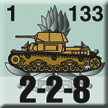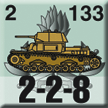| Littorio
at Gazala
By Mike Bennighof, Ph.D.
July 2018
Erwin Rommel launched Operazione Venezia
in May 1942 in order to forestall a planned
British offensive. The Axis army seized the
initiative and won a signal victory at Gazala.
While Rommel received note for taking great
personal risks during the battle and providing
needed on-the-spot leadership, his biggest
gamble probably came before the battle began.
Our Gazala game provides a scenario for a British offensive
coming first, putting the Axis on the defensive.
Like the “historical” scenario
of the Axis offensive it’s a finely-balanced
contest. It would not have taken much to bring
victory to either side.

Avanti Savoia!
The Axis had three armored divisions and
two motorized divisions. Two of the armored
divisions were German, one Italian. All three
were battle-hardened formations, though the
Italian division, 132nd “Ariete,”
had inferior tanks. The two motorized divisions
were not as good as the armored units, the
90th for the Germans and 101st “Trieste”
for the Italians, but still better than average.
Rommel did have a fourth armored division
on its way to the front, but chose to strike
quickly rather than await its arrival. The
first units of the Italian 133rd “Littorio”
Armored Division had arrived in Tripoli, the
capital and major port of Libya, as early
as January, 1942. But the rest of the division
did not land until March.
Littorio was the third Italian armored division
formed, and always considered not quite as
professional as the first two (Centauro and
Ariete). The original Littorio Division had
fought in the Spanish Civil War as a unit
of regular army “volunteers.”
On its return to Italy in early 1939, it was
converted to an armored division but kept
the fascist-inspired name (literally “lictor”;
in ancient Rome, the lictors carried the fasces,
those rod-and-axes symbols of state power
adopted by Mussolini two millennia later.
Thus the division’s name might be metaphorically
translated as “Standard Bearer of Fascism.”).
Littorio saw action in the 1941 campaign
against Yugoslavia and performed quite well.
The Armored Corps had been designed to defeat
the Yugoslavs, and did so. It was never intended
for desert operations, but the need in Libya
and Egypt for mobile formations had become
urgent. Ariete, already serving in Libya,
had priority for new equipment.
  
By April, the division had reached Benghazi
in northeastern Libya. The march took place
very slowly, as the division’s transport
had been diverted to bring vitally-needed
supplies to the front. The divisional history
blames Allied air attacks for slowing its
advance, but neither Rommel nor the Italian
XX (Mobile) Corps commander, Ettore Baldassare,
seem to have been in a great hurry to rush
the untested division to the front and preferred
to bring their existing formations to full
strength. Ariete went into battle greatly
overstrength in tanks, artillery and especially
anti-aircraft guns, at Littorio’s expense.
Littorio did not participate in the Gazala
battle, though British accounts usually include
its troop and tank strengths in the Axis total.
A small battlegroup arrived in the combat
zone on 20 June, as the battle was ending,
and participated in the attack on Tobruk.
But Littorio would not actually enter combat
for some weeks yet.
However, players the like their tanks, and
we’ve included a small download with
the Axis strategic reserve: the 25th “Bologna”
Infantry Division, the 133rd “Littorio”
Armored Division and the “Young Fascists”
(GGFF) regimental battle group. For game purposes,
all of the 133 units are part of XX Corps;
those of 25th are part of X Corps. GGFF may
be assigned to any formation. At the start
of each turn beginning on 10 June, the Axis
player rolls one die for each division and
one for GGFF. On a result of 6, all units
of the division (Littorio’s are all
marked 133; Bologna’s two regiments
are 25) or GGFF are available as reinforcements.
The Allies also had more troops on the way,
the 10th Indian Division. This unit’s
20th Brigade appears in the game as a reinforcement,
but 21st and 25th Brigades were also moving
to the combat zone. At the start of each turn
beginning on 10 June, the Allied player also
rolls one die. On a result of 6, the three
units of 10th Indian Division (10th headquarters,
21st Brigade and 25th Brigade) are available
as reinforcements.
To download the free counters, click
here.
Click here to order Gazala, our action-packed
and
eminently affordable game of desert warfare!
Mike Bennighof is president of Avalanche Press and holds a doctorate in history from Emory University. A Fulbright Scholar and award-winning journalist, he has published over 100 books, games and articles on historical subjects.
He lives in Birmingham, Alabama with his wife, three children and his dog, Leopold.
|
